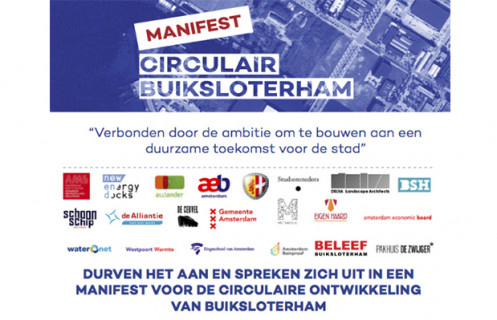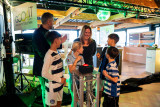Buiksloterham, on the northern bank of the IJ waterway, once the site of Amsterdam’s most polluting industries, is being transformed into a sustainable area to live and work.
The living lab is described in the following report.
Full report (english)
Full report (dutch)
Want to know more about the status of Circular Buiksloterham after 5 years of innovation and pioneering?
Join us during the Event 'Circulair Buiksloterham, 5 jaar later' on the 26th of March in Pakhuis de Zwijger. The event will be in Dutch. Check <https://dezwijger.nl/programma/circulair-buiksloterham-5-jaar-later>
What is the goal of the project?
Over the coming years, Buiksloterham will develop into a sustainable district, based on circular principles. It will be up to the project partners in Buiksloterham to determine the particular issues that need to be solved.
What is the result of the project?
The City of Amsterdam is one of the signatories of a manifest which has been drawn up in order to emphasise the circular ambitions of the project. Over the next 10 years, Buiksloterham will be transformed into a circular neighbourhood where products and raw materials are reused as much as possible.
Who initiated the project and which organizations are involved?
City of Amsterdam – with 20 organisations (see image)
What is the next step?
On March the 5th 2015 more than 20 different organisations and companies signed the Circular Buiksloterham Manifest. Together they are working to transform Buiksloterham into a sustainable and circular district. Various initiators are actively engaged in projects and experiments in and around the area. For more information see the Buiksloterham website.
On the website of the city of Amsterdam you can see an overview of development projects at Buiksloterham. To stay up to date about the next steps: https://www.amsterdam.nl/wonen-leefomgeving/bouwprojecten/bouw/groteprojecten/buiksloterham/
What can other cities learn from your project?
The Circular City and Sustainability embrace themes like energy, intelligent use of materials, recycling, climate resilience, and sustainable mobility, as well as the shift from ownership to usership (sharing economy) and the development of new models for production, consumption, distribution and logistics.
The City of Amsterdam is facilitating and supporting the development of Buiksloterham into a sustainable and circular district. Self-builders, people that are building their own houses, are also invited to make a contribution. The Circular Buiksloterham option form, Keuzekaart Circulair Buiksloterham (PDF, 185 kB), supports individual self-builders in realising a sustainable home with circular elements. By chosing concrete measures at an early stage, ustainability can be easily implemented in the project. It is therefore compulsory for self-builders at Buiksloterham to complete, sign and submit this form. While individual self-build projects are not selected on the basis of sustainability, the compulsory form shows to which extent the self-builder is including sustainability and circularity in the plans.
When granting building plots, Amsterdam City Council, selects on the basis of circularity and sustainability. This has been the policy at Buiksloterham for many years, and will remain so the coming year. Amsterdam City Council also applies sustainability in areas , such as refuse collection methods, LED lighting in public space, and in the process of realizing sustainable heating and cooling.





